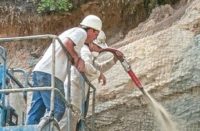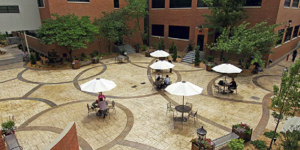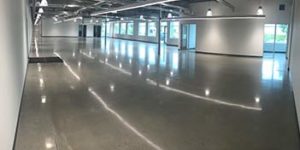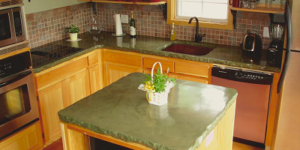Outdoor kitchens are a popular request no matter where you live, but typically when you read a book or see a television show featuring outdoor kitchens, the contractor is doing them in a warm climate. Warmer climates allow the use of these all year round. But that doesn’t mean that folks up north won’t want one in their backyard too. Here in Ohio, we continue to get more and more calls from homeowners regarding these.
Unfortunately, some of the calls we get are from disgruntled homeowners who have purchased outdoor-kitchen kits intended for a warm climate only to have them fall apart after a winter here. They now need repairs done or want it trashed altogether.
Why kits don’t work in cold climates
A outdoor-kitchen kit typically includes a preordered, premade frame, usually stucco, HardieBacker fiber-cement board or stone veneer, plus prefab tile or granite countertops and other materials. The kit ships in pieces to be completed by the homeowner or contractor on-site.
Many times the homeowner — or even a contractor — is enticed to purchase a kit online due to the cost factor, as these are usually about half the cost of a custom-built kitchen.
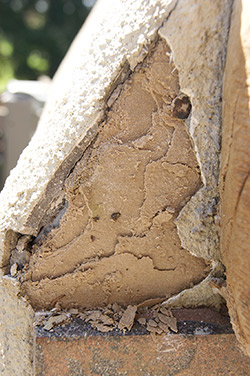
Proper communication with the homeowner regarding expectations and possible future issues will usually persuade them to at least educate themselves a little better on these. However, even after given a proper explanation of the problems, I still have had one homeowner say: “Well, if one goes bad, I will just buy another one.” (That was my cue to pick up my stuff and leave.)
The problems with an online kit begin with the fact that it comes in pieces for shipment. It has to be bolted or screwed together. Any time you fasten something together, you create a weakened spot where you can get moisture intrusion and movement, which can lead to cracking or the start of a delaminating surface.
Then, once the kitchen is constructed, it needs to be bolted to concrete. In Ohio we have control joints every 8 to 10 feet. If the kitchen happens to go over the top of one of these control joints, bad things can happen due to movement between the slabs during freeze/thaw cycles.
Lastly, most of them that I have seen or been called out to look at use HardieBacker board as sheeting to stick the finished product to. What a lot of people do not realize is that when water gets into the HardieBacker board it freezes and expands, and the material flakes off in layers taking whatever is on it with it.
Your outdoor kitchen should have a footing that isolates it from the rest of the slab, and you should use actual cement board, which is often confused with HardieBacker board.
Different footers for different climates
A proper outdoor kitchen constructed for a cold-weather climate definitely begins with a foundation that is below the frost line. We pour a footer after I finalize a design for the kitchen.
I have seen many books with outdoor kitchen plans that show a picture or a diagram of how the job can be done in a warm-weather climate. Those plans would not work here because the foundation and footer shown are not deep enough to withstand the effects of cold weather. Different areas have different codes on what that depth should be. In my area it is 3 feet from the surface to the bottom of the footer.
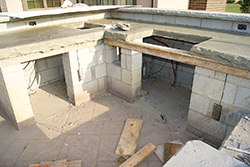
Why we use cement block
Next, I hire a block mason to lay cement blocks per our design. Even though we could lay the block ourselves, it doesn’t always make sense financially, because we can make more money doing another job than we can fooling around with cement blocks. I have tried to form and pour the kitchen walls instead of using cement blocks. However, this took three times as much labor as what my mason can do it for.
Another benefit to cement block is that you get a great surface to pour your concrete countertop on. And it is extremely porous, allowing a great bond with whatever you decide to face the block with. Stucco, artificial stone, vertical carving and so on should never be an issue. These things will not deteriorate and are not going to move.
After the block work is completed we pour the concrete around the area, using some form of expansion joint anywhere the concrete touches the block.
Outdoor tops and appliances
Exterior countertops are different from the ones you do inside. I recommend you give them some slope to get water off. Obviously, anytime water sits on anything for too long it can lead to problems — discoloration, sealer issues, puddles, etc. — and the customer may not be too happy to come out to grill a hamburger after a rain only to find that their grill is flooded.
Also, I would strongly advise you to do your homework on the sealer you use. Not all interior countertop sealers will work on outside applications. Make sure you talk to the manufacturer or supplier of any product to find out if it will work.
One last tip that could save you some headaches no matter what climate you are from is make sure you have the appliances on hand before you start. I prefer to actually personally measure each appliance being installed to ensure a proper fit.
When I first started doing outdoor kitchens, a couple gave me the dimensions of a grill that was different from the one they actually ordered. There is nothing worse than completing a beautiful countertop only to find out when installing the grill that the opening is too small. Luckily, we could cut and grind the opening to fit the grill. However, it was still not fun and cost us a lot of time. That was the last time I made that mistake.

